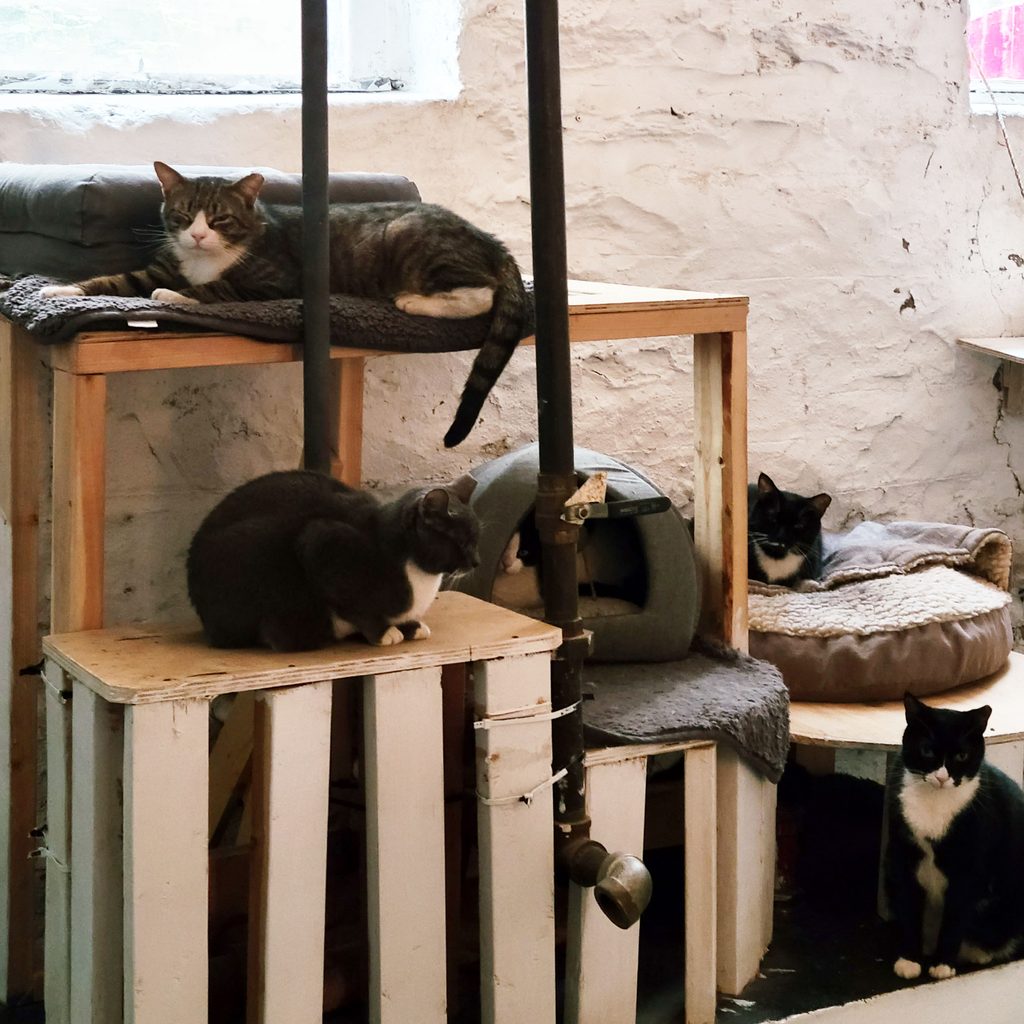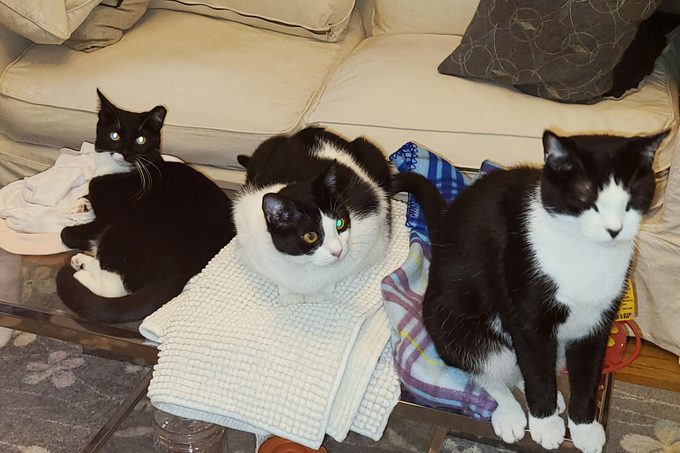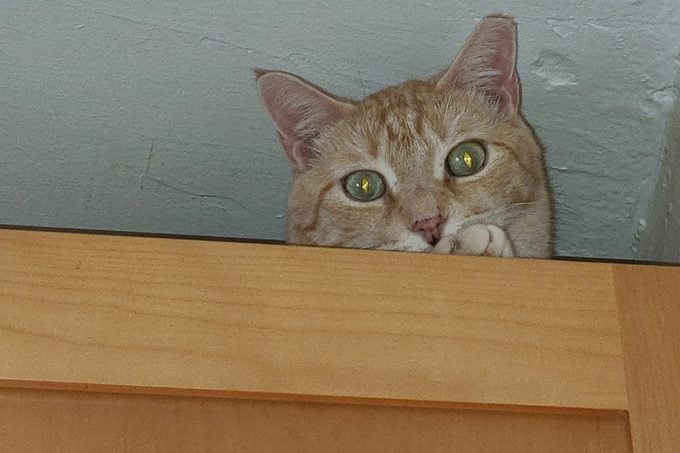I Rescue 100 Cats a Year—Here’s What I Want You to Know
Updated: Nov. 07, 2022

Each day a cat is rescued is an emotional rollercoaster of heartache and triumph, and Denise wouldn't have it any other way.
I live in New York City, and my first “official” cat rescue was 18 years ago. Sylvester (the cat) was dipped in some kind of commercial adhesive and glued to Amsterdam Ave at 190th street. He was in the street next to a can of food. I took off one of my shirts, wrapped him up, and brought him home and have been rescuing cats non-stop ever since.
I started rescuing animals in grade school
I brought everything home when I was a kid. Back then, I lived in Englewood, New Jersey. My parents weren’t thrilled with it, but I brought home all kinds of critters—including cats. I would ask my mother to buy tuna. Little did she know I was showing the neighborhood cats how to get into my basement and feeding them tuna. One day my mother went to the pantry to get some tuna to make a sandwich, only to find no tuna—busted! But most of the cats I rescued lived with us, or we found homes for them.
I turned a basement into a cat sanctuary
Before I created Denise’s Washington Heights Sanctuary a year ago, I rescued roughly 50 cats a year and took them back to my apartment. Some cats were adopted; some were found to have microchips from other rescue groups and returned to them. I also kept some. My landlord gave me the space in the basement to create a kitty sanctuary. But it was in horrible shape—inches of dirt on the floor from years of flooding and boarded-up windows that needed replacing. It took a few months and thousands of dollars to clean and paint it, but now it’s a safe home for the cats I rescue. Since creating the cat sanctuary, I’ve rescued more than 100 cats. Currently, I have approximately 38 cats. Half are in the sanctuary and half are in my apartment.
My army of volunteers
Although I do all day-to-day care and most of the rescues, it’s basically a full-time job—in addition to my dog-walking gig. I have a small army of online minions that share my posts and get the word out. They respond to people giving away pet goods, food, litter, and toys, and throw my name in the hat. I have a couple of people that will transport animals, pick up goods, etc. too, and people who regularly check in to make sure everything is okay and if I need anything. If I have a large or difficult rescue and need a second set of hands, friends jump right in—no matter what the weather is like outside. If you’re an animal lover, you’ll want to know about the things shelters desperately need right now.

It’s not cheap
I’m lucky to get some donations for food and litter, and neutering and spaying and shots are free through the ASPCA. However, the Snap test, which tests for FIV (feline immunodeficiency virus) and FeLV (feline leukemia virus), is $45 per cat. (Cats who test positive for those are sent to special sanctuaries equipped to care for them.) But I pay all vet costs for injuries or illness, plus de-worming and monthly Revolution, which protects cats from fleas.
It’s frustrating when my efforts are hindered
I live in upper Manhattan, where there are approximately 500 acres of wooded parkland, and hundreds of cats are dumped in these parks every year. What makes it extremely frustrating to rescue these cats is that there is a New York Restoration Project, and the New York City Parks Department won’t communicate with us when they remove the invasive plant species in these parks. When the invasive plants are removed, the natural burrow the cats live in is often plugged up or destroyed. Yet, when these burrows are left alone, we can trap a mama cat and her babies, making our work easier.
This is what I do when I find a cat
Since there are so many cats in need and so few rescuers, it is essential to work with integrity. No one is a “professional.” No one is perfect. We all make mistakes when it comes to rescuing cats. Always walk softly on someone else’s turf. First, I record/document where I found the cat and their living conditions. Each police precinct in New York City has a chip reader to scan for microchips with the pet’s information. If yours doesn’t, I recommend taking the cat to your local shelter, which will scan for a microchip. They may also be aware of the missing cat from an owner who reported them missing.
Next, I start posting, asking for help. NEVER post your location—it’s like bait for animal abusers who come out of the woodwork, like people who answer ads only to use the dog in dog fights or people who poison animals. If possible, bring the cat home and put them in a spare room or bathroom. If they are injured, get them to a veterinary hospital. If you don’t have cat supplies on hand, just use a box or a disposable baking tin as a litter box, with some shredded newspaper for the litter. I typically use old towels for bedding because they’re easy to wash. And if you don’t have cat food on hand, tuna, boiled shredded chicken, or even baby food work for cat food. Here’s what vets say you should feed your little lion.
Some cats are easier to rescue than others
In New York City, I don’t think we have true feral cats; they are mostly dumped house cats. As far as I know, “ferals” don’t come near people and don’t make eye contact. I do think people are quick to label a cat “feral” and think it’s not adoptable. I have several “ferals” in my apartment. One is Peanut. I brought him into my apartment, and he hates me. One day he got out of my third-floor apartment when a repairman accidentally let him out. Long story short, he made his way back to a feeding station and the trap I put out. The relief on his face was evident when he saw me. It’s as if he was saying, “It’s about time!” He’s home now with his crew, and yes, he still hates me. On the flip side, there’s Frenchie, a “feral” baby maker from the park. She headbutt-demands attention and dinner. She’ll never be adopted because she bonded with me, and that’s that! This is the difference between a feral cat and a stray cat.

Rescuing older kittens
The ASPCA helped me once with some kittens, but that was a rare occasion, as they are extremely overwhelmed. Most rescue groups don’t have the manpower to do the actual rescue. Every situation is different, depending on the age of the kittens, how friendly they are, and where they are. Once I’ve figured that out, I stalk the cats to try to see how many there are, and then I plan accordingly. If they’re in a relatively safe place, I feed them a few times and set up a regular feeding schedule. Hopefully, at this time, the cats begin to trust me. Finally, I drop trap, a humane way to capture cats. If mama stands back to let the babies eat first, I grab the kittens and use them as bait to get her. If I come upon a lone kitten, I’ll take it home for its health and safety and come back and search for others later. Don’t miss these happy stories of kittens and puppies that found foster homes during the pandemic.
Caring for newborn kittens requires around-the-clock care
Recently we found Little Broadway all by himself on Broadway (hence the name). We searched for the mama and siblings, but none were found. He was between two to three weeks old and wouldn’t take the bottle, so I used a syringe to get kitten milk replacer (KMR) in him, which he drinks about every four hours. (By the way, never use cow’s milk for kittens!) I immediately tried getting him interested in food by dipping my finger in baby food and rubbing it on his lips every two to three hours. He’s now eating kitten food on his own. Little Broadway is a little confused about the litter and keeps peeing in the big cats’ dry food bowls. Understandably, they are not amused! He’ll get the hang of it.
One last thing about kittens: Try to use the shredded paper litter. The dusty clumping litter can be dangerous when kittens ingest it. Cats have a lot of instinctual behaviors—this is why they know how to use a litter box.
There’s corruption in rescuers
There’s a lot of room for corruption when dealing with egos and unscrupulous “rescuers.” I’ve had rescue groups claim me as one of their rescuers and collect donations meant for my sanctuary that were never forwarded to me. I know this because people have sent me tracking numbers of donations sent to my group, attention to me, with instructions to give to me, never forwarded to me.
It’s so worth it
The best part is when the cats thank me. It may be subtle: a facial expression, a purr, or when they snuggle up next to me. Other times, cats make it more obvious by crawling into your lap or becoming your new shadow. My heart melts when I see them relax in the window, learn what a comfy chair is for, or make biscuits in their new bed. Even when the cats don’t make it, I’m keeping them from dying alone in the street and showing them kindness and love. It tears my heart out, but I hope it is peaceful for them. As rewarding as rescuing cats is, I do get discouraged all the time. When I do, I take a breath and sit in the cat sanctuary. I watch these cats that are fat and happy and watch the videos of my adopted cats and how loved they are now with their new families. Knowing they came from the street and now have a loving home is the greatest feeling in the world and makes it all worth it. You’ll purr over these before-and-after cat adoption photos of cats that found forever homes.